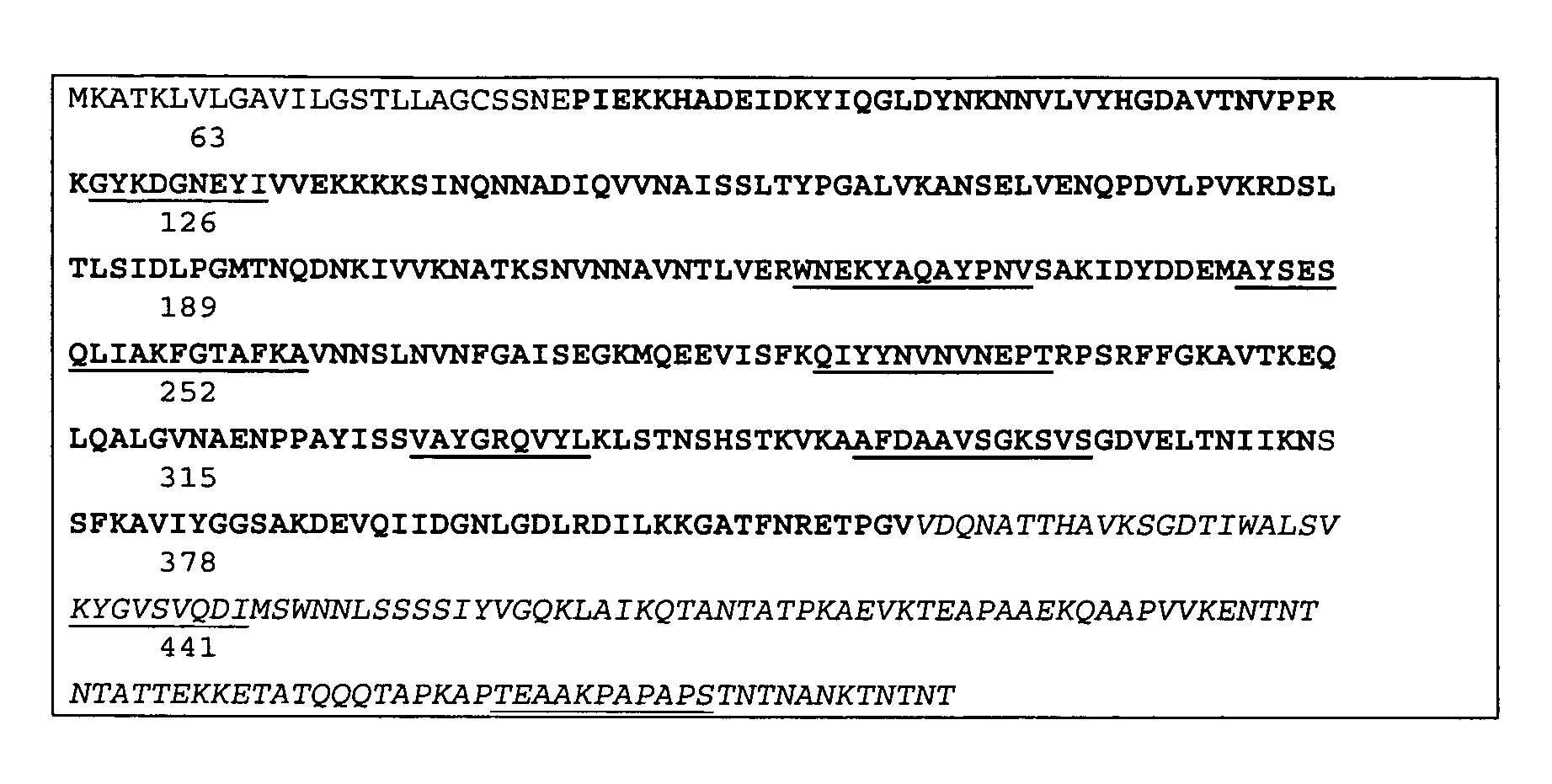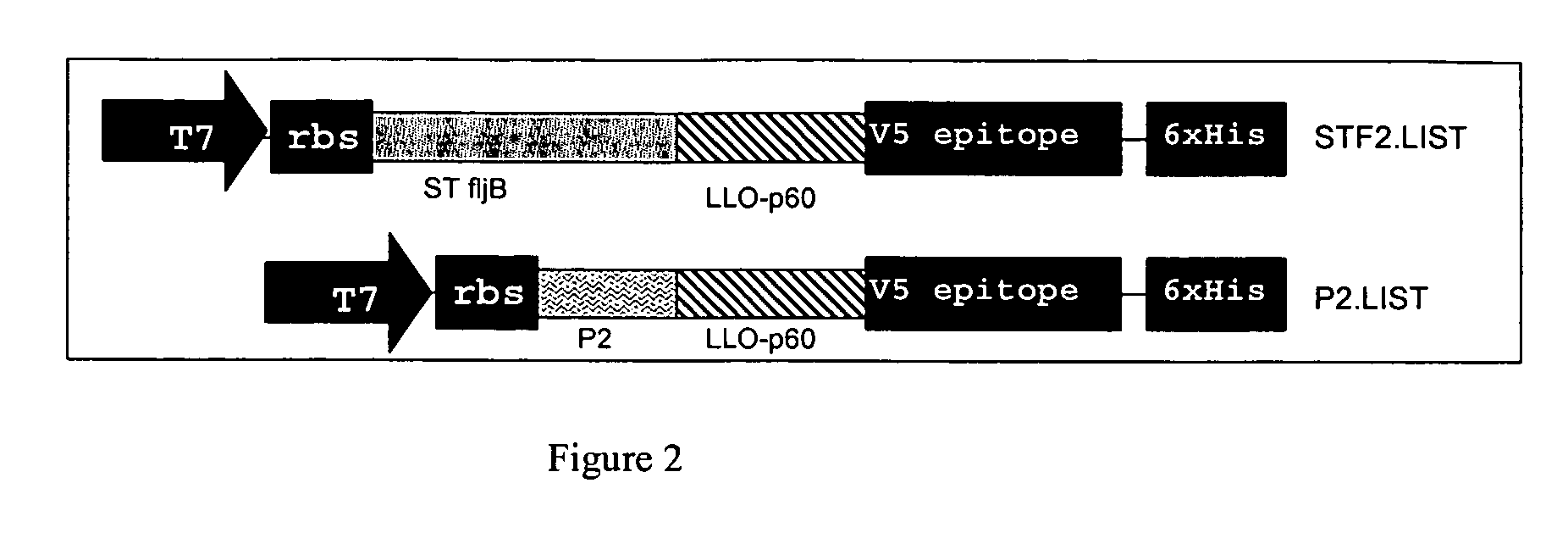Compositions of pamps and Listeria monocytogenes and methods of use
a technology of listeria monocytogenes and compositions, applied in the field of compositions of pamps and listeria monocytogenes and methods of use, can solve the problems of i>l. monocytogenes /i>infection that can have devastating effects, complicated control of i>l. monocytogenes /i>, and miscarriage rates
- Summary
- Abstract
- Description
- Claims
- Application Information
AI Technical Summary
Benefits of technology
Problems solved by technology
Method used
Image
Examples
example 1
PAMP.LIST Constructs
Materials and Methods
[0155]Sequences encoding the signal sequence and lipidation motif of E. coli lipoprotein (SEQ ID NO: 2; amino acid 1-24; designated P2), Salmonella typhimurium flagellin fljB (SEQ ID NO: 6; designated STF2), E. coli outer membrane protein A (SEQ ID NO: 4) and L. monocytogenes LLO48-379 (SEQ ID NO: 10) and p60193-319 (SEQ ID NO: 9) were cloned by employing sets of primers derived from the published sequences of the various using genomic bacterial DNA as the template in a PCR reaction. The flagellin sequences of this construct were isolated from S. typhimurium genomic DNA by PCR using the following primers: forward (5′ ATG GCA CAA GTA ATC AAC ACT AAC 3′ (SEQ ID NO.: 22) and reverse (5′ CTC GAG ACG TAA CAG AGA CAG CAC GTT CTG 3′ (SEQ ID NO.: 23). Primers used for the amplification of OmpA are as follows: ECOMPA-F: 5′ AATGAAAAAGACAGCTATCGCGATTGCAGTGGCACTG-3′ (SEQ ID NO.: 24) (forward) and OMBHD-R2: 5′ AAGCTTCGAATTGCCCTTAGCCTGCGGCTGAGTTACAACG-3′ (...
example 2
Protein Expression, Purification and Confirmation
Materials and Methods
[0164]Protein expression and immunoblot assay: E. coli strain BL21 (DE3) pLysS (Invitrogen) was transformed with DNA purified from P2.LIST and STF2.LIST using a commercially available kit (Qiagen). A colony was inoculated into 2-ml LB containing 100 μg / ml carbenicillin, 34 μg / ml chloramphenicol supplemented with 0.5% glucose and grown overnight at 37° C. with shaking. A fresh 2-ml culture was inoculated with a 1:20 dilution of the overnight culture and grown at 37° C. for several hours until OD600=0.5-0.8. Protein expression was induced by the addition of IPTG to 1 mM for 3 hours. The bacteria were harvested by centrifugation and the pellet was re-suspended in 100 μl of 1×SDS-PAGE sample buffer in the presence of β-mercaptoethanol. The samples were boiled for 5 minutes and 1 / 10 volume of each sample was loaded onto 10% SDS-PAGE gel and electrophoresed. The samples were transferred to PVDF membrane and probed with ...
example 3
Analysis of Proteins & Confirmation of Activity
Materials and Methods
[0167]Cell lines expressing TLR and luciferase reporter: 293, 3T3, and RAW cells were assayed by RT-PCR to determine endogenous expression of Toll-like receptors 2, 4, and 5. For each cell line, an NF-κB reporter vector containing tandem copies of the NF-κB consensus sequence upstream of a minimal promoter fused to the firefly luciferase gene was co-transfected with a vector containing an antibiotic resistance gene for selecting stable clones. 293luc (fibroblast, TLR expression 2−4−5+), 3T3κB (fibroblast, TLR expression 2+4+5−) and RAWκB (macrophage, TLR expression 2+4+5−) cell lines are utilized to measure NF-κB dependent luciferase activity triggered by the activation of specific Toll-like receptors 5, 4, and 2, respectively. When NF-κB transcription factors produced by the activation of Toll-like receptors bind to the cis-acting enhancer element in the reporter vector, transcription is induced and luciferase is m...
PUM
| Property | Measurement | Unit |
|---|---|---|
| temperatures | aaaaa | aaaaa |
| pH | aaaaa | aaaaa |
| pH | aaaaa | aaaaa |
Abstract
Description
Claims
Application Information
 Login to View More
Login to View More - R&D
- Intellectual Property
- Life Sciences
- Materials
- Tech Scout
- Unparalleled Data Quality
- Higher Quality Content
- 60% Fewer Hallucinations
Browse by: Latest US Patents, China's latest patents, Technical Efficacy Thesaurus, Application Domain, Technology Topic, Popular Technical Reports.
© 2025 PatSnap. All rights reserved.Legal|Privacy policy|Modern Slavery Act Transparency Statement|Sitemap|About US| Contact US: help@patsnap.com



